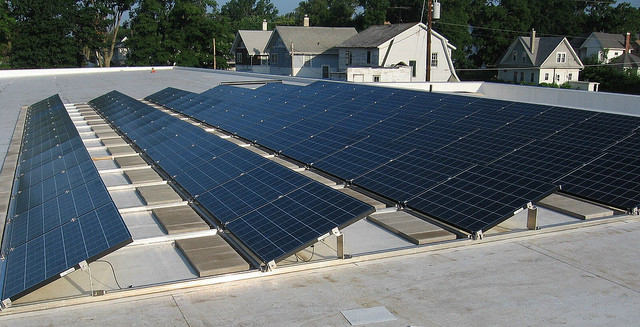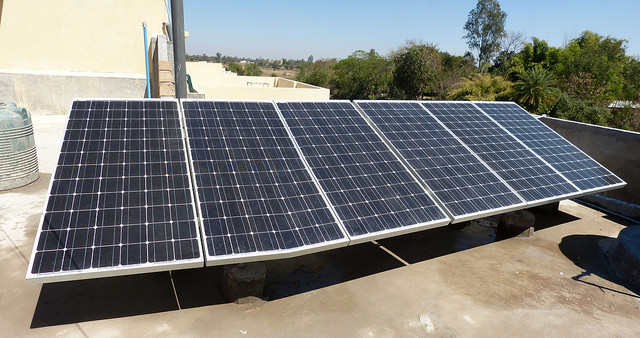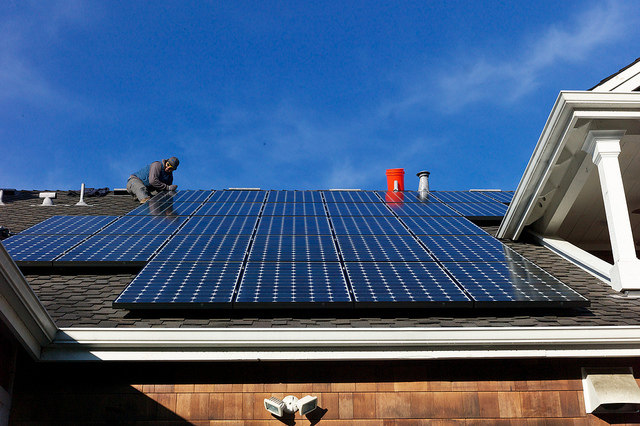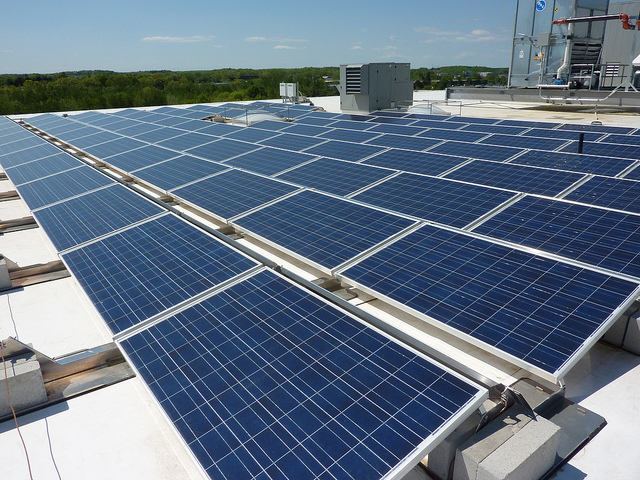Can You Put Solar Panels on a Flat Roof?

Residential solar panels are commonly seen installed on pitched roofing. But can you put solar panels on a flat roof?
I’m happy to report that yes, you can indeed put solar panels on a flat roof! In fact, if you own a home with a flat roof and you’re considering getting solar power installed, then you’re in an enviable position. Though there are some trade-offs to contend with, in general, having a flat roof gives you a number of advantages over your pitched-roof peers.
Can I put solar panels on a flat roof just like on a pitched roof?

One of the most important factors when designing a solar system is the orientation of the array. If you’re creating a system to be installed on a pitched roof, you’re limited by the shape and structure of that roof. The direction and angle of the roof dictate the direction and angle of the panels. Though you can make some adjustments by making allowances in the racking, deviating too far from the set of the roof can be unsightly, as well as making the installation process significantly more complicated and driving up the cost.
In contrast, a flat roof gives you the freedom to install your solar panels facing in any direction you’d like. You’re free to set them at the ideal angle for your location, and the only physical limiting factor you have to deal with is the size and shape of the roof’s supporting structure. Anything installed on the roof needs to be solidly anchored into the joists, especially if you’re in an area that ever sees high winds. Weight might also be a concern if the roof is particularly light, but that’s unlikely to stop you for reasons I’ll go into shortly.
Making it pretty

Another concern is the aesthetics of the installation. On a pitched roof, you’re usually forced to display the solar panels for all to see, and they can have a dramatic effect on the look of the property. Whether the look is a good one is going to depend on the quality of the installation and personal taste — but even if you like them, you can’t guarantee your neighbors will. Particularly if your property is under the jurisdiction of an Homeowners Association (HOA), this is something you might need to worry about. Some HOAs can be quite strict about where you can install solar panels on your roof. If you’re very lucky, you might have a suitable side of the roof that isn’t easily visible, but if not you’ll just have to do the best you can.
With a flat roof, however, you have an advantage — unless you’re at the bottom of a hill or next to a much taller property, it’s unlikely that your neighbors will even know the panels are there. Even more so from street level, especially if your flat roof is surrounded by a parapet wall. You have much greater freedom to place your panels without worrying overmuch about the aesthetics.
Getting up there
Working on a flat roof generally makes the installation process much easier. On a pitched roof, the installer may have to deal with delicate tiles, slates or shingles, whereas most surfaces used on flat roofs are a great deal more robust. Access to the panels themselves becomes more simple. When working on a pitched roof, a contractor likely needs a ladder or scaffolding as well as harnesses, rope, and other specialist safety gear. A flat roof, in most cases, will only need a safe method of access.
Accessibility is also a concern for maintaining and cleaning the system. Though most solar panels are usually self-cleaning, having your system installed on a flat roof enables you to do hassle-free routine checks more easily than if it was installed on a pitched roof.
Another reason you might want access is if you have panels with an adjustable angle installed. By changing the angle between winter and summer operation, you can squeeze a few extra percent of power out of your panels. Most residential installations don’t bother with this, but if you’re looking to get the absolute most out of your system then a flat roof is the ideal place for an adjustable array.
What if the roof is fragile?
Even if you’re dealing with a thin, fragile flat roof, the chances are you can still enjoy the benefits of solar power. Thin film solar panels are ideal for situations like this. Although generally speaking they’re less efficient than the more common crystalline silicon panels, thin film panels have a lot of advantages. Comparatively, they tend to be cheaper and they’re a lot lighter. You often see them installed on the top of agricultural sheds or big industrial buildings. They aren’t without their downsides, though. You need to cover a larger area to get the same amount of energy and they also tend to have a shorter lifespan — but they’re still a viable option and the technology is improving every year.
How big does the roof need to be?

One factor you might have to consider is how much space is available on the roof. If you’re dealing with a very small roof, then how many panels can physically fit on the roof is a concern. One solution to this is placing the panels at a very shallow angle so they can be closer together without shading each other. It’s not an ideal answer, though. If you go lower than 10–15° you may run into problems with the panels needing an excessive amount of cleaning — not to mention the efficiency trade-offs.
In conclusion
If your home has a flat roof, then you’re actually in a better position than many people with pitched roofs. Though flat roofs have their foibles, they are easily worth the hassle, so you can install solar with confidence. If you’ve had a solar system installed on your flat roof, or you’re looking into it, I’d love to hear about your experiences in the comments below.
